Redefining Working Out With Chronic Illness
[This is a guest post from Alexandra Hust, blogger and founder of Alexandra Organica. In this post Alexandra shares her tips and experience for working out with a chronic illness, especially if your chronic illness involves chronic pain.]
When you think of working out, what comes to mind?
Hulk-sized men eating weights for breakfast?
Maybe you think about a group of women doing synchronized moves to the latest pop hits in a group fitness class?
Or maybe you think of something else entirely like running, yoga, or spinning?
But what if you had a chronic illness and these traditional forms of exercise were no longer plausible?
Would you just have to sit down and never work out again?
One of the biggest epidemics in America is how many people are living with one or more chronic conditions.
During my time working at a local gym, I spent countless hours listening to people explain to me the woes of not being able to work out or be healthy due to their ailments.
But what if the real problem was how we defined working out?
Regular exercise is one of the main factors in managing chronic illness symptoms and preventing them from ever occurring.
This post may contain affiliate links, which helps keep this content free. Please read our disclosure for more info.
Is it Really an Epidemic?

About half of all Americans suffer from at least one chronic condition, and that’s 133 million who suffer and have been suffering for at least six months.
Since nearly one out of every two Americans suffer from a chronic condition, either you or someone you know will have to deal with one of these types of health issues.
What are these chronic conditions?
- Heart disease
- Diabetes
- Autoimmune disease
- Arthritis
- Depression/ Anxiety
- ADHD
- Hormonal imbalances
- Digestive problems
- Skin problems
But is there anything you can do after the dreaded sentence of a diagnosis, or worse, knowing that something is wrong but not being able to pinpoint it?
Actually, yes! I’m sure you even know the “what” of what you can do to help your illness. These include:
- Eating a healthy diet
- Managing your stress
- Sleeping 7-9 hours a night
- Getting physical activity
Whether we struggle with chronic illness or not, we all know that we need more physical activity.
But with chronic conditions, we often have pain, exhaustion, weakness, and mental health struggles that make working out a huge battle.
Going to the gym? Forget it.
Hike with friends? Absolutely not.
Sometimes walking up the stupid stairs in your house can be too much of an exertion.
But what if we redefined what we thought of as exercise?
How to Start from Ground Zero
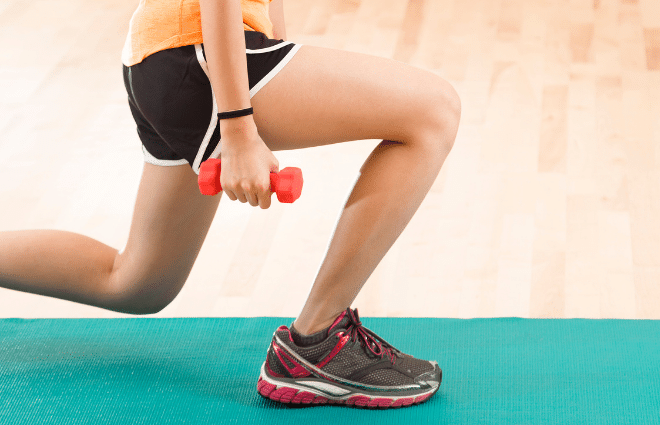
Starting a new exercise routine is daunting for anyone, especially for those of us with other struggles.
Often when we are sick, we’re told we need to start all of these changes at once.
At the beginning of my fitness journey, I would start a new supplement, new workouts, change lots of different health activities simultaneously.
I could never tell which ones helped or hurt me by adding all these changes at once.
Introduce only one change at a time, whether it is a type of exercise, medicine, supplement, or a new diet, so you can see what and how it affects your condition.
But then what if we feel like we really can’t add a workout, for whatever reason that may be?
It feels easier to accept that we are too sick to work out and can’t make any changes. For some of us, that may be true.
But you need to ask yourself questions to know if you are doing all that you can to be in a place where you can be working out.
- Are you doing everything you can to support your condition and set yourself up for success?
- Keeping your condition manageable can look like taking your medicine, getting at least 8 hours of sleep, staying hydrated, avoiding triggers, and focusing on having a positive and grateful mindset.
- Are you struggling with being too exhausted?
- If you know you are prone to exhaustion, try to get the bulk of your work done in the mornings, focus on getting enough quality sleep, and get an extra kick by drinking green tea or diffusing essential oils that promote energy.
- Are you struggling with being in too much pain to work out?
- When you struggle with chronic pain, you understand that there is your average pain and worse pain during flares. To support your pain management, you can take your meds, anti-inflammatory supplements, try CBD oil, massage therapy, or an anti-inflammatory diet.
Working out is 10x harder for people with chronic illnesses who aren’t supporting their bodies already.
Support your condition by taking your meds, supplements, sleeping enough, drinking plenty of water, and anything else in your power to feel your best.
If you’re taking care of yourself and feel ready to start a routine, the biggest issue I’ve seen in myself and the clients I’ve worked with, going too hard out of the gate.
I remember when I tried a plyometrics class after weaning off medication for my chronic illness and nearly ended up on the floor. Not only did I try a new exercise without easing into it, but I also was changing a medication.
The story’s point is that you tend to have more self-awareness as someone with a chronic condition.
This self-awareness helps you learn to listen to your body, not to push yourself past your limits and get injured or flare your illness.
Start Out Slow and Low-Impact
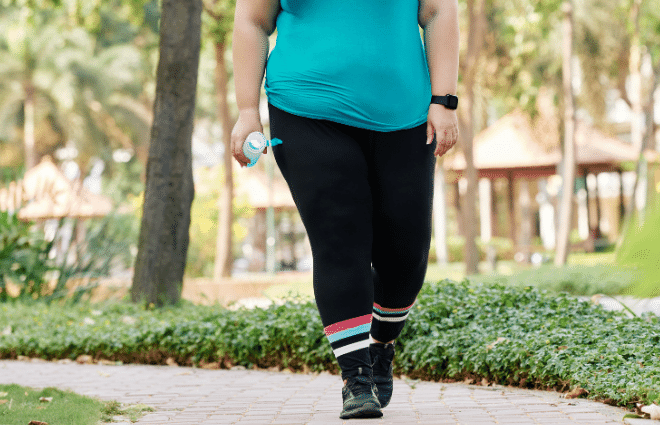
People always think, well, I used to run 2 miles a few years ago, but it’s been a while. They go for it, thinking it’ll be fine, and that’s how they injure themselves.
When you start up your new exercise routine, go for low impact and nothing too extreme.
Changes in the seasons and weather tend to flare my Postural Orthostatic Tachycardia Syndrome (or POTS for short), so I tend not to make changes to my exercise routine or diet during this time.
Many fitness influencers and motivational speakers will tell you to start now and not wait for the right time.
There will never be a right time.
And while I do think this has some validity with us chronically ill, we don’t need to start something in the middle of a storm either.
If you wake up in pain but know that your pain subsides in the afternoon, plan to get your workout in the afternoon. Your time of day can matter greatly depending on your condition.
People with different chronic conditions feel best at different times of the day.
With POTS, I typically feel good upon waking, but during flares, my exhaustion gets progressively worse throughout the day, so good luck trying to get me to work out in the evening.
If I don’t work out in the morning, I won’t be able to later.
Working out with a chronic condition is like a game; you need to know when to play, how to play, and when to fold.
Slow and steady wins the race, and make sure you’re only playing one game at a time.
Low Impact Exercises for People With Chronic Illnesses
1. Walking
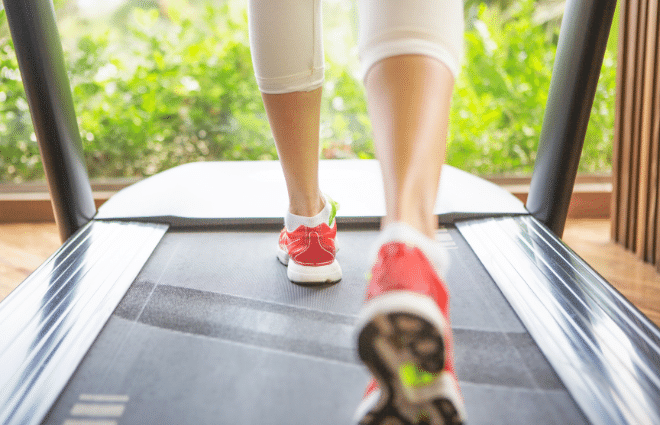
While walking seems like a no-brainer, people often fail to see what great exercise it is.
Walking is a great way to get your heart rate up, and it is better for your body than running.
No hate for running, I do enjoy that, but it can be hard on your joints, especially if you have arthritis or fibromyalgia, or something else that affects the joints.
When I was in physical therapy for my POTS, I did my exercise on a treadmill. This way, we could monitor my heart rate, so if I started having a flare, I would be able to quit my workout.
If you chose to build up your strength and endurance by walking outside, you would have to get back home somehow, even if you were flaring.
By starting your exercise program in a controlled environment, you can stop when needed, rather than push yourself if you stray too far from home and find yourself in a flare.
2. Seated Exercises
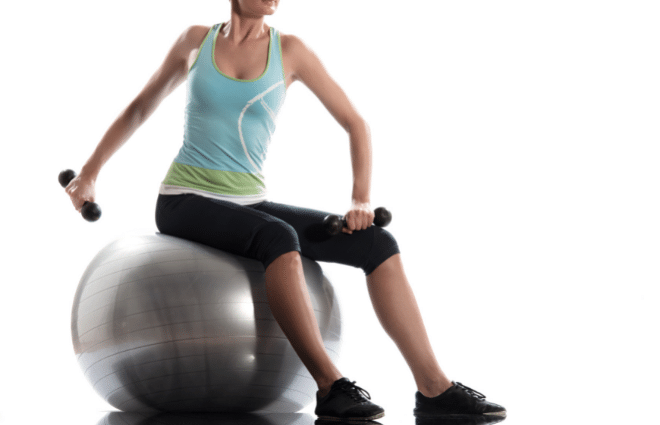
As a trainer, I have noticed that people often feel like sitting means they aren’t working as hard to perform an exercise.
As someone positionally challenged (my illness flares more when standing), I know that I will get a better workout if I’m seated.
If I’m seated, I don’t have to worry as much about flaring my illness if I exert myself too hard.
If I’m standing, I might not give a total effort in an attempt to keep my disease at bay.
However, if I’m seated, I will feel safer from getting dizzy or weak and get a better workout.
Using seated machines at the gym, doing a seated group fitness class, or performing exercises from a chair or couch in your home can be a great way to modify the workout.
These exercises don’t need to be complicated, and they can be as simple as marching while seating or moving your arms in a circular motion.
It all depends on what you can do physically and meeting yourself at your level.
3. Yoga or Stretching

There are many forms of yoga, some harder than other ones.
But gentle forms of yoga such as Hatha or restorative yoga can be a great way to start.
Yoga focuses on your breathing, mindset, and core, which can improve many chronic conditions, as well as be helpful to lowering stress levels, which in turn usually improves your symptoms.
There are many yoga classes that you can attend at local gyms, from gentle yoga to more intense yogas. There are even different types of chair yoga for folks who might struggle with getting on and off the floor.
Avocadu’s Yoga Fat Loss Bible is a great self-paced yoga program that’s perfect for beginners, and can be done from the comfort of home.
Even just stretching can be a great way to get your body moving.
You will help loosen up the body to alleviate pain and stiffness by moving your body at all.
Stretching will also help with better blood flow which will help your body perform its functions properly.
Exercise doesn’t have to be sweaty or strenuous, and it can be as simple as intentional stretching.
4. Recumbent bike
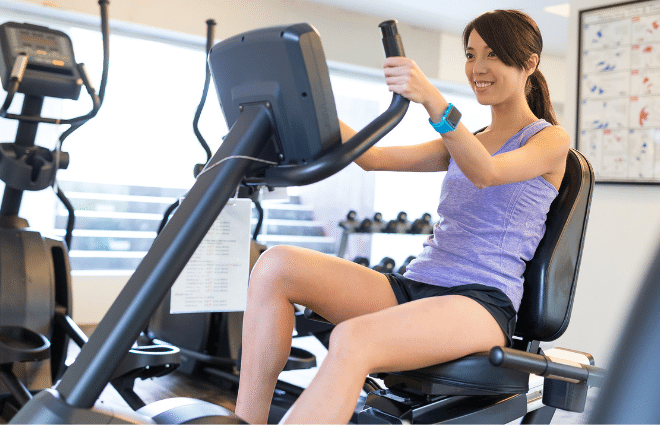
Another favorite for low-impact cardio is the recumbent bike, not to be confused with a spin bike.
A recumbent bike has a much wider seat, so it’s not balancing like a regular bike.
This way, you can focus on the movement in your legs, you can change the resistance to make it easier or harder.
It’s a great way to loosen the muscles and get the heart rate up.
5. Physical Therapy
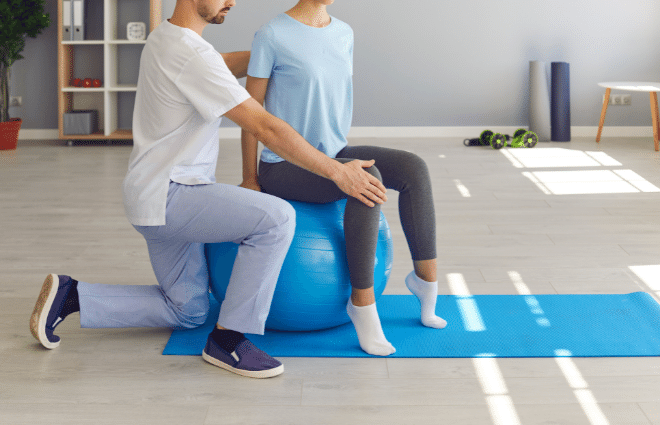
I worked for about three years at a gym that was attached to a physical therapy office.
I didn’t realize how many people come in for chronic condition management.
I had thought physical therapy was primarily injuries from events like falling, being in a car accident or even having a heart attack.
If you’re concerned about working out and doing so ever so carefully around your chronic condition, I recommend seeing if your doctor can refer you to a physical therapist.
If you’re unable to do that, looking for a personal trainer with experience with your condition or specializing in rehabilitation could be super helpful.
My favorite thing about having a physical therapist was that the moves they recommend are easy but highly effective.
6. Swimming

Do you know that swimming is considered one of the best forms of exercise?
When swimming, there is no stress on your bones, joints, or muscles, making it easier for people who struggle with pain.
Swimming can help you strengthen your lungs, which is excellent for people with asthma or other lung-related issues.
Swimming is a double whammy since it is both cardio and strength training.
Since it is so low impact, swimming is more accessible for people with all fitness levels to participate.
7. Chores

One of the hardest things for me has always been chores.
And while part of it is my personality (oops), a big part of it is because I’m chronically ill–I’m already exhausted from work, and my other tasks and so house cleaning isn’t a top priority of mine.
However, your exercise and your chores can be two birds with one stone.
Adding activity to your daily routine doesn’t have to look like a traditional workout.
Fitness can be:
- doing your laundry
- taking an extra trip to get the groceries out of the car
- parking further away from your destination
When you already spend all your energy trying to work, go to doctor’s appointments, keep up with your family can make adding exercise feel impossible, but there are ways to exercise without the weights.
Working out is what you make it to be.
Final Tips

My biggest challenge in redefining working out for myself was getting embarrassed that I couldn’t do certain things.
I would worry that people would watch me if I modified an exercise at the gym.
Even if I was alone, I was just so hard on myself for not being where I wanted to be.
Over time, I learned that no one is watching you at the gym, and the only way you can get to where you want to go is by taking that first step.
You are not jumping to step 10, where you will injure yourself or flare your condition and end up back to step -5.
Be okay with having to modify and listen to your body. You know how you feel, and you have to be careful within reason, of course.
Finally, try new things.
It’s okay if you mess up, fail, or can’t do all the exercises or moves.
Try a water aerobics class or tai chi, or take the dog for a walk.
Exercise doesn’t have to be miserable, and you shouldn’t have to be in pain or avoid it altogether to participate.
It’s hard to feel embarrassed to modify exercises or force yourself to work out when it would be easier to skip it.
But letting your disease control your life is also hard, and you get to choose your hard.
Ready to Get Started?
If you’re ready to get your body moving and start improving your health, yoga is a great place to start.
Our Yoga Fat Loss Bible has everything you need to get started, and it’s a great solution for those looking to lose weight, get more flexible, and relieve aches and pains with a calm yoga practice.
It provides detailed instructions and beginner modifications for your practice + a 6-Week Workout Plan any beginner can start with!
Click here to read more about the Yoga Fat Loss Bible!
Always remember that the most difficult part of doing any exercise or yoga program is SHOWING UP.
Make sure to show up today and give your best to your new workout routine. You deserve it, and your body will thank you!
About the Author:

My name is Alexandra Hust, and I am a health and fitness coach and blogger. I have been on my health and fitness journey for eight years, and I have been a NASM certified personal trainer for about four years now.
My passion lies in researching and learning more about holistic health, especially as it pertains to the gut and the power of your mindset. My goal is to help women take control of their health by focusing on gut health, low-carb nutrition, and booty building.
